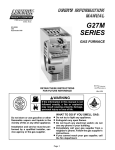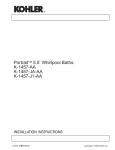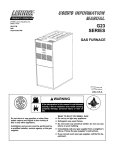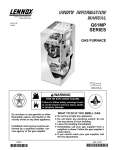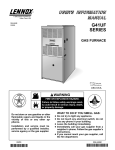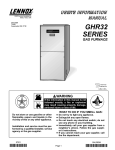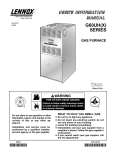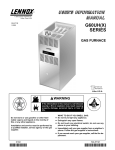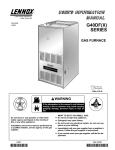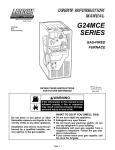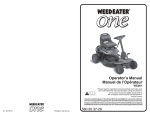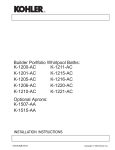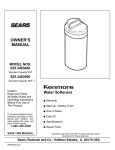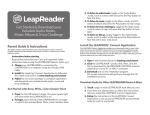Download Lennox International Inc. G21 User's Manual
Transcript
PRODUCT LITERATURE 1996 Lennox Industries Inc. Dallas, Texas G21Q & V SERIES 503,072M 8/99 Supersedes 6/96 GAS FURNACE Litho U.S.A. WARNING If the information in this manual is not followed exactly, a fire or explosion may result causing property damage, personal injury or loss of life. Do not store or use gasoline or other flammable vapors and liquids in the vicinity of this or any other appliance. Installation and service must be perĆ formed by a qualified installer, serĆ vice agency or the gas supplier. WHAT TO DO IF YOU SMELL GAS: D Do not try to light any appliance. D Extinguish any open flames. D Do not touch any electrical switch; do not use any phone in your building. D Immediately call your gas supplier from a neighbor's phone. Follow the gas suppliĆ er's instructions. D If you cannot reach your gas supplier, call the fire department. E1994 Lennox Industries Inc. G21 (Q & V) Series Parts Arrangement LIMIT CONTROL DIFFERENTIAL PRESSURE SWITCH GAS VALVE EXPANSION TANK AIR INTAKE CONNECTION CONTROL BOX AIR VALVE AND AIR HOUSING LOW VOLTAGE TERMINAL STRIP G21Q SERIES BLOWER MOTOR BLOWER G21V SERIES BLOWER MOTOR DOOR INTERLOCK SWITCH FIGURE 1 For Your Safety, Read Before Lighting CAUTION Before attempting to perform any service or mainteĆ nance, turn the electrical power to unit OFF at disĆ connect switch. WARNING Do not use this furnace if any part has been underĆ water. Immediately call a qualified service techniĆ cian to inspect the furnace and to replace any part of the control system and any gas control which has been under water. WARNING If overheating occurs or if gas supply fails to shut off, shut off the manual gas valve to the appliance before shutting off electrical supply. Page 1 WARNING Do not set the thermostat below 60_F (16_C) when it is in heating mode. Setting the thermostat below 60_F (16_C) reduces the number of heating cycles. Damage to the unit may occur that is not covered by the warranty. BEFORE LIGHTING smell all around the appliance area for gas. Be sure to smell next to the floor beĆ cause some gas is heavier than air and will settle on the floor. Use only your hand to push in or move the gas control lever or switch. Never use tools. If the lever or switch will not push in or move by hand, do not try to repair it, call a qualified service technician. Force or attempted repair may result in a fire or explosion. Important Directions 1. Keep the furnace area clear and free of combustible material, gasoline, and other flammable vapors and liquids. If installed in an insulated area, furnace must be kept free of insulating material. Insulating material may be combustible. 2. DO NOT obstruct air flow to unit. Unit must receive an unobstructed flow of combustion and ventilatĆ ing air. 3. DO NOT store chlorine or fluorine products near unit or introduce these products into the combustion air. These products can cause furnace corrosion. 4 - DO NOT draw the return air from a room where another gas appliance (ie., a water heater) is installed. Even though this furnace draws its comĆ bustion air from outside of the structure, other gas appliances that share a utility room may not. When return air is drawn from a room, a negative pressure is created in the room. If a gas appliance is operating in a room with negative pressure, the flue products can be pulled back down the vent pipe and into the room. This reverse flow of the flue gas may result in incomplete combustion and the formation of carbon monoxide gas. This toxic gas might then be distribĆ uted through the house by the furnace duct system. Your furnace is a gas appliance. It is critical that the gas supplied to the unit be completely burned to avoid the proĆ duction of carbon monoxide gas. Complete combustion of the gas requires, but is not limited to, correct gas presĆ sure and gas flow rate, adequate combustion, air, and proper venting. gas appliances. Reliable detectors are available at reaĆ sonable retail prices. Contact your independent Lennox dealer for more details about this investment in your safety. Your furnace is designed to meet standards set by nationĆ al agencies, and to operate safely when properly installed and maintained. However, the unit's performance can be greatly impacted by the individual installation and the opĆ erating environment. It is your responsibility to ensure that this appliance is maintained. Proper maintenance is critical for your safety and the satisfactory operation of the product. Lennox strongly recommends annual inĆ spection and maintenance of this appliance. Contact your independent Lennox dealer for an inspection by a qualified service technician. Unit Operation This appliance does not have a pilot. It is equipped with an ignition system which automatically lights the burner. Do not try to light by hand. A-Gas Valve Operation WARNING If you do not follow these instructions exactly, a fire or explosion may result causing property damage, personal injury or death. Gas Valve Operation for Robertshaw and White Rodgers Valves (Figures 2 and 4) ROBERTSHAW 7200 GAS VALVE GAS VALVE SELECTOR ARM IN OFF POSITION WARNING Carbon monoxide gas is invisible, odorless, and toxic Exposure to this gas can cause personal injury and even death to all occupants, including pets. Any item that is powered by or gives off heat from a combustion process (including lawn mowers, automobiles, and fireplaces) has the potential to produce carbon monoxide gas. Because of this, Lennox recommends the use of a carbon monĆ oxide detector in your home, even if you do not own Page 2 WHITE RODGERS 36E GAS VALVE GAS VALVE SHOWN IN OFF POSITION FIGURE 2 THERMOSTATS FIGURE 3 1- Set thermostat to lowest setting. See figure 3. 2- Turn off all electrical power to furnace. See figure 5. 3- This appliance Is equipped with an ignition device which automatically lights the burner. Do not try to light the burner by hand. 4- Remove unit access panel. 5- On Robertshaw 7200 gas valve, depress lever on gas control and move to OFF and release. For White Rodgers 36E gas valves, move switch to OFF. Do not force. Page 3 6- Wait five (5) minutes to clear out any gas. Smell for gas, including near the floor. If you then smell gas, STOP! Immediately call your gas supplier from a neighbor's phone. Follow the gas supplier's instrucĆ tions. If you do not smell gas go to next step. 7- On Robertshaw 7200 gas valve, depress lever on gas control and move to ON and release. For White Rodgers 36E gas valves, move switch to ON. 8- Replace unit access panel. 9- Turn on all electrical power to unit. 10- Set thermostat to desired setting. See figure 3. 11- If the furnace will not operate, follow the instructions To Turn Off Gas To Unit" and call your service techniĆ cian or gas supplier. B-To Turn Off Gas To Unit 1- Set thermostat to lowest setting. 2- Turn off all electrical power to unit if service is to be performed. 3- Remove heat section access panel. 4- On Robertshaw 7200 gas valve, depress lever on gas control and move to OFF and release. For White Rodgers 36E gas valves, move switch to OFF. 5- Replace unit access panel. GAS PIPING TABLE 1 MANUAL MAIN SHUT-OFF VALVE AUTOMATIC GAS VALVE GROUND JOINT UNION Filter Size Filter Part No. All Q-40,-60, Q3-80, Q4-80 and V3-60, -80 units 16" x 25" (406 x 635mm) P-8-7822 Q5-80 and all Q-100 units: and V5-80,-100 units 20" x 25" (508 x 635mm) P-8-7831 5- Reinstall filter. Slide filter into top channel and drop into lower channel. DRIP LEG RIGHT SIDE PIPING G21 Model No. IMPORTANT-Do not replace foam reusable filters with throw-away type filters. GAS CONNECTOR 6- Replace blower access panel. FIGURE 4 Lubrication Motors are prelubricated for extended bearing life; no further lubrication is required. Service At the beginning of each heating season, the system should be checked as follows: FOR UNIT TO OPERATE DISCONNECT SWITCH MUST BE IN ON" POSITION 1- Examine the termination ends of the intake and exĆ haust lines for obstructions or blockages. 2- Check the intake and exhaust lines for holes, sagĆ ging or broken isolation hangers. If a sag is found in either line, raise the line and support it with an isolaĆ tion hanger. Replace any damaged isolation hangĆ ers. TYPICAL FUSE/DISCONNECT SWITCH BOX MOUNTED ON FURNACE FIGURE 5 Servicing the Filter Inspect and clean air filters each month. Filters must be cleaned when dirty to assure proper furnace opĆ eration and maintain efficiency. A-Cleaning Reusable Foam Filter 1- Turn off electrical power to furnace. 2- Remove blower access panel. Wait for blower to stop. 3- Remove filter by sliding up and out of channel. 4- Wash filter with water and a mild detergent. For inĆ creased efficiency, filter media should be sprayed with Filter Handicoater when dry. Filter Handicoater is RP products No. 418 and is available as Lennox part No. P-8-5069. See table 1 for replacement filters. Page 4 3- The return air duct connection should be sealed to the furnace casing and terminate outside the space containing the furnace. 4- Check the physical support of the furnace. It should be sound without sagging, cracks, gaps, etc., around the base so as to provide a seal between the support and the base. 5- Check that there is no obvious signs of deterioration of the furnace. 6- Inspect and clean condensate drain system for free flow of condensate. IMPORTANT-If a change in the sound level of the unit is detected or there is evidence of condensate leakĆ age around the unit, contact your Lennox service technician. Service Reminder Call your Lennox service technician if the unit is inopĆ erative. Before calling, always check the following to be sure service is required: 1- Be sure electrical switches are ON. 2- Check the room thermostat for proper setting. 3- Replace any blown fuses or reset circuit breakers. 4- Make sure gas valve is on. 5- Blower access panel is in place. 6- Air filter must be clean. Safety Precautions If you discover any of the following, shut down your unit, and contact an independent Lennox dealer for an inspection by a qualified technician. D If you repeatedly hear any new or unfamiliar sounds while your unit is operating, there may be a problem. For example, poorly performing burners can produce unfamiliar noises. D If you smell any unusual odors, your unit may be operĆ ating improperly. For example, units can give off unfaĆ miliar odors if components are required to operate in abnormal conditions. D Look for visible signs of a malfunctioning unit. ExamĆ ples include unusual amounts of condensate on winĆ dows inside your house, visibly burnt components or unusual dirt or rust accumulations on the vent pipe or in the unit. D If you experience headache, nausea, fatigue, or dizziĆ ness, the cause could be exposure to carbon monoxĆ ide gas. This is often misdiagnosed as the flu because symptoms are similar. If you suffer from flu-like sympĆ toms that are exaggerated at home, but seem to subĆ side while you are away from the house, exposure to carbon monoxide could be the cause. Your vigilance may pay off in early detection of a problem Page 5 before either personal injury or property damage occurs. Do not hesitate to contact a qualified service technician as an investment in your well being. Planned Service You should expect a service technician to check the following items during an annual inspection. Power to the unit must be shut off for the service technician's safety. Fresh air grilles and louvers (on the unit and in the room where the furnace is installed) - Must be open and unobĆ structed to provide combustion air. Burners- Must be inspected for rust, dirt, or signs of water. Vent pipe - Must be inspected for dirt, signs of water, damĆ aged or sagging unsupported pipe, or disconnected joints. Unit appearance - Must be inspected for rust, dirt, signs of water, burnt or damaged wires, or components. Blower access door - Must be properly in place and provide a seal between the return air and the room where the furnace is installed. Return air duct - Must be properly attached and provide an airtight seal to the unit. Operating performance - Unit must be observed during opĆ eration to monitor proper performance of the unit and the vent system. Combustion gases - Flue products must be analyzed and compared to the unit specifications. Problems detected during the inspection may make it necesĆ sary to temporarily shut down the furnace until the items can be repaired or replaced. Pay attention to your furnace. Situations can arise beĆ tween annual furnace inspections that may result in unsafe operation. For instance, items innocently stored next to the furnace may obstruct the combustion air supply. This could cause incomplete combustion and the production of carbon monoxide gas.







